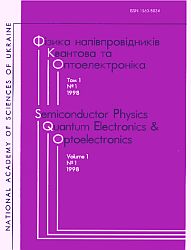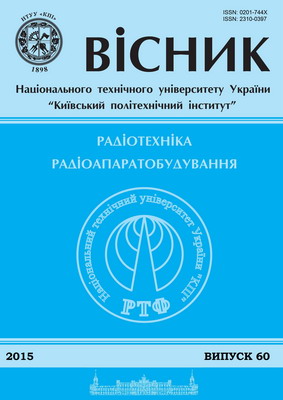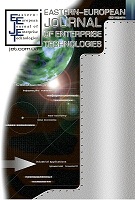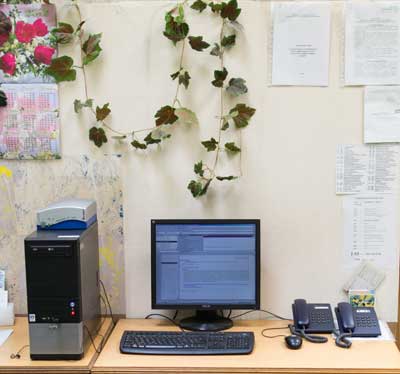
Бази даних
Наукова періодика України - результати пошуку
 |
Для швидкої роботи та реалізації всіх функціональних можливостей пошукової системи використовуйте браузер "Mozilla Firefox" |
|
|
Повнотекстовий пошук
| Знайдено в інших БД: | Реферативна база даних (5) |
Список видань за алфавітом назв: Авторський покажчик Покажчик назв публікацій  |
Пошуковий запит: (<.>A=Timofeyev V$<.>) | |||
|
Загальна кількість знайдених документів : 5 Представлено документи з 1 до 5 |
|||
| 1. | 
Timofeyev V. I. Model of heterotransistor with quantum dots [Електронний ресурс] / V. I. Timofeyev, E. M. Faleyeva // Semiconductor physics, quantum electronics & optoelectronics. - 2010. - Vol. 13, № 2. - С. 186-188. - Режим доступу: http://nbuv.gov.ua/UJRN/MSMW_2010_13_2_18 Heterostructure transistors with quantum dots (QD) are now very perspective devices because of their higher velocities of electrons in the channel. Simulation results for concentration and carrier velocity distributions depending on the QD size, concentration and location were presented in this paper. It is shown that presence of QD in the channel causes a significant increase of current. Also, QD location and concentration influence to the output characteristics of transistor was established. | ||
| 2. | 
Chekhovych M. G. Using of the machine learning methods to identify bronchopulmonary system diseases with the use of lung sounds [Електронний ресурс] / M. G. Chekhovych, A. S. Poreva, V. I. Timofeyev, P. Henaff // Вісник Національного технічного університету України "Київський політехнічний інститут". Серія : Радіотехніка. Радіоапаратобудування. - 2018. - Вип. 73. - С. 55-62. - Режим доступу: http://nbuv.gov.ua/UJRN/VKPI_rr_2018_73_10 Сучасні технічні й електронні засоби надають змогу проводити медичну діагностику на більш високому рівні, швидше, точніше і комфортніше для пацієнта та лікаря. Здатність записувати легеневі звуки дозволяє обробляти сигнали та використовувати технології машинного навчання, щоб автоматично аналізувати записані звуки для забезпечення діагностичної підтримки. Аналіз легеневих звуків, зібраних шляхом аускультації є основним компонентом діагностики захворювань легень для первинної медичної допомоги та загального моніторингу стану пацієнтів. Розробка комп'ютерних алгоритмів для вивчення легеневого звуку надає більш широкі дослідницькі можливості. Досліджено та проаналізовано сучасні методи цифрового аналізу звуків легень. Кожен з існуючих методів надає певний результат у розв'язанні конкретної проблеми, це може бути, як і обезшумлення сигналу, так і знаходження тих чи інших артефактів звуків дихання. Розглянуто можливість застосування класифікаторів, що є основою машинного навчання, для оптимізації постановки діагнозів захворювань легень. Розглянуто роботу декількох класифікаторів на основі попередньо розрахованих параметрів з використанням апарату статистик вищих порядків. Встановлено, що метод опорних векторів, а також дерево прийняття рішень є простими та найточнішими класифікаторами для реалізації і для роботи з базою звуків дихання. Одержана точність роботи класифікаторів є досить високою. Симбіоз різних методів цифрової обробки з сучасними інструментами машинного навчання надасть змогу суттєво підвищити точність роботи методів, а також значно полегшити роботу лікаря. | ||
| 3. | 
Kulikov K. Modeling the dynamic properties of III-nitrides in strong electric fields [Електронний ресурс] / K. Kulikov, V. Moskaliuk, V. Timofeyev // Восточно-Европейский журнал передовых технологий. - 2021. - № 1(5). - С. 37-52. - Режим доступу: http://nbuv.gov.ua/UJRN/Vejpte_2021_1(5)__6 This paper proposes a method of modeling the dynamic properties of multi-valley semiconductors. The model is applied to the relevant materials GaN, AlN, and InN, which are now known by the general name of III-nitrides. The method is distinguished by economical use of computational resources without significant loss of accuracy and the possibility of application for both dynamic time-dependent tasks and the fields variable in space. The proposed approach is based on solving a system of differential equations, which are known as relaxation ones, and derived from the Boltzmann kinetic equation in the approximation of relaxation time by the function of distribution over k-space. Unlike the conventional system of equations for the concentration of carriers, their pulse and energy, we have used, instead of the energy relaxation equation, an equation of electronic temperature as a measure of the energy of the chaotic motion only. Relaxation times are defined not as integral values from the static characteristics of the material but the averaging of quantum-mechanic speeds for certain types of scattering is used. Averaging was carried out according to the Maxwellian distribution function in the approximation of electronic temperature, as a result of which various mechanisms of dispersion of carriers are taken into consideration through specific relaxation times. The system of equations includes equations in partial derivatives from time and coordinates, which makes it possible to investigate the pulse properties of the examined materials. In particular, the dynamic effect of the "overshoot" in drift velocity and a spatial "ballistic transport" of carriers. The use of Fourier transforms of pulse dependence of the drift carrier velocity to calculate maximum conductivity frequencies is considered. It has been shown that the limit frequencies are hundreds of gigahertz and, for aluminum nitride, exceed a thousand gigahertz. | ||
| 4. | 
Dunaevsky V. Monitoring the condition of vegetables, fruit, and plants using infrared thermography [Електронний ресурс] / V. Dunaevsky, Y. Venher, A. Liptyha, V. Kotovskyi, V. Timofeyev, S. Nazarchuk // Харчова наука і технологія. - 2020. - Т. 14, Вип. 4. - С. 98-104. - Режим доступу: http://nbuv.gov.ua/UJRN/Khnit_2020_14_4_13 | ||
| 5. | 
Slyusar V. Construction of an advanced method for recognizing monitored objects by a convolutional neural network using a discrete wavelet transform [Електронний ресурс] / V. Slyusar, M. Protsenko, A. Chernukha, S. Gornostal, S. Rudakov, S. Shevchenko, O. Chernikov, N. Kolpachenko, V. Timofeyev, R. Artiukh // Eastern-european journal of enterprise technologies. - 2021. - № 4(9). - С. 65-77. - Режим доступу: http://nbuv.gov.ua/UJRN/Vejpte_2021_4(9)__9 The tasks that unmanned aircraft systems solve include the detection of objects and determining their state. This paper reports an analysis of image recognition methods in order to automate the specified process. Based on the analysis, an improved method for recognizing images of monitored objects by a convolutional neural network using a discrete wavelet transform has been devised. Underlying the method is the task of automating image processing in unmanned aircraft systems. The operability of the proposed method was tested using an example of processing an image (aircraft, tanks, helicopters) acquired by the optical system of an unmanned aerial vehicle. A discrete wavelet transform has been used to build a database of objects' wavelet images and train a convolutional neural network based on them. That has made it possible to improve the efficiency of recognition of monitored objects and automate a given process. The effectiveness of the improved method is achieved by preliminary decomposition and approximation of the digital image of the monitored object by a discrete wavelet transform. The stages of a given method include the construction of a database of the wavelet images of images and training a convolutional neural network. The effectiveness of recognizing the monitored objects' images by the improved method was tested on a convolutional neural network, which was trained with images of 300 monitored objects. In this case, the time to make a decision, based on the proposed method, decreased on average from 0,7 to 0,84 s compared with the artificial neural networks ResNet and ConvNets. The method could be used in the information processing systems in unmanned aerial vehicles that monitor objects; in robotic complexes for various purposes; in the video surveillance systems of important objects. | ||
 |
| Відділ наукової організації електронних інформаційних ресурсів |
 Пам`ятка користувача Пам`ятка користувача |